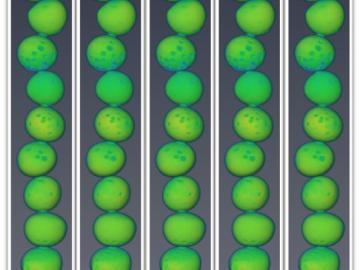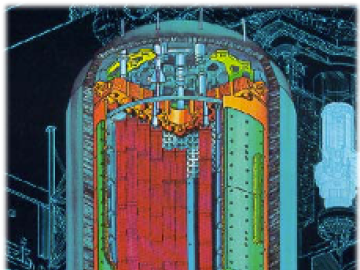
Filter News
Area of Research
- (-) Advanced Manufacturing (6)
- (-) National Security (24)
- (-) Neutron Science (39)
- (-) Nuclear Science and Technology (38)
- Biological Systems (1)
- Biology and Environment (28)
- Computational Biology (2)
- Computational Engineering (1)
- Computer Science (3)
- Electricity and Smart Grid (3)
- Energy Science (84)
- Fuel Cycle Science and Technology (1)
- Functional Materials for Energy (1)
- Fusion and Fission (47)
- Fusion Energy (17)
- Isotope Development and Production (1)
- Isotopes (11)
- Materials (106)
- Materials Characterization (1)
- Materials for Computing (17)
- Materials Under Extremes (1)
- Nuclear Systems Modeling, Simulation and Validation (1)
- Quantum information Science (1)
- Sensors and Controls (2)
- Supercomputing (46)
- Transportation Systems (1)
News Topics
- (-) Biomedical (18)
- (-) Fusion (11)
- (-) Grid (6)
- (-) Materials Science (31)
- (-) Nuclear Energy (42)
- (-) Polymers (1)
- (-) Security (12)
- 3-D Printing/Advanced Manufacturing (31)
- Advanced Reactors (13)
- Artificial Intelligence (19)
- Big Data (8)
- Bioenergy (12)
- Biology (11)
- Biotechnology (2)
- Buildings (1)
- Chemical Sciences (5)
- Clean Water (2)
- Composites (4)
- Computer Science (34)
- Coronavirus (13)
- Cybersecurity (20)
- Energy Storage (8)
- Environment (13)
- Exascale Computing (1)
- Fossil Energy (1)
- Frontier (2)
- High-Performance Computing (6)
- Hydropower (1)
- Isotopes (5)
- Machine Learning (16)
- Materials (20)
- Mathematics (1)
- Microscopy (3)
- Molten Salt (4)
- Nanotechnology (11)
- National Security (35)
- Neutron Science (122)
- Partnerships (5)
- Physics (11)
- Quantum Computing (1)
- Quantum Science (8)
- Simulation (1)
- Space Exploration (9)
- Summit (7)
- Transportation (7)
Media Contacts

Oak Ridge National Laboratory researchers working on neutron imaging capabilities for nuclear materials have developed a process for seeing the inside of uranium particles – without cutting them open.

A software package, 10 years in the making, that can predict the behavior of nuclear reactors’ cores with stunning accuracy has been licensed commercially for the first time.

A versatile class of flexible, protein-like polymers could significantly advance future drug delivery methods. But first, scientists have to develop a reliable process for tailoring these polymers into shapes that can effectively transport medicines throughout the human body.

The techniques Theodore Biewer and his colleagues are using to measure whether plasma has the right conditions to create fusion have been around awhile.

Biological membranes, such as the “walls” of most types of living cells, primarily consist of a double layer of lipids, or “lipid bilayer,” that forms the structure, and a variety of embedded and attached proteins with highly specialized functions, including proteins that rapidly and selectively transport ions and molecules in and out of the cell.

OAK RIDGE, Tenn., Feb. 19, 2020 — The U.S. Department of Energy’s Oak Ridge National Laboratory and the Tennessee Valley Authority have signed a memorandum of understanding to evaluate a new generation of flexible, cost-effective advanced nuclear reactors.

An international team of researchers has discovered the hydrogen atoms in a metal hydride material are much more tightly spaced than had been predicted for decades — a feature that could possibly facilitate superconductivity at or near room temperature and pressure.

A typhoon strikes an island in the Pacific Ocean, downing power lines and cell towers. An earthquake hits a remote mountainous region, destroying structures and leaving no communication infrastructure behind.

To better determine the potential energy cost savings among connected homes, researchers at Oak Ridge National Laboratory developed a computer simulation to more accurately compare energy use on similar weather days.

Researchers at Oak Ridge National Laboratory demonstrated that an additively manufactured polymer layer, when applied to carbon fiber reinforced plastic, or CFRP, can serve as an effective protector against aircraft lightning strikes.


